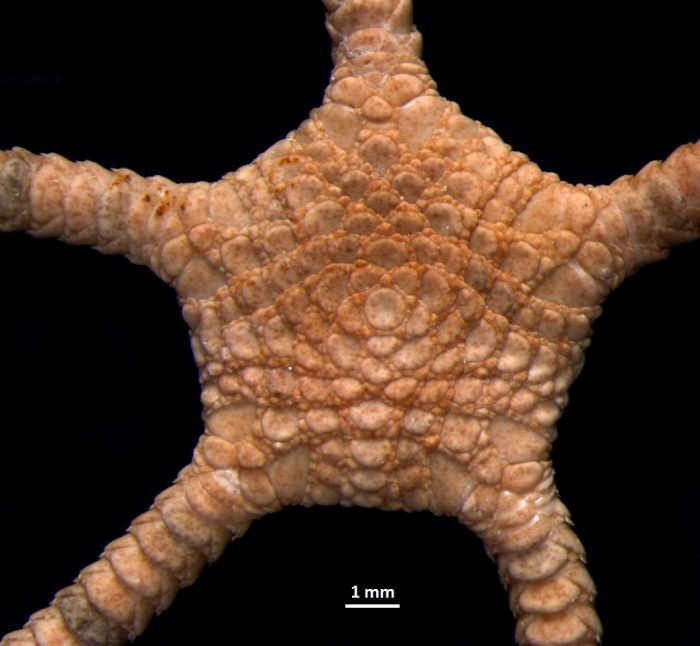
Phylum: Echinodermata
Class: Ophiuroidea Gray, 1840
Order: Amphilepidida O’Hara, Hugall, Thuy, Stöhr & Martynov, 2017
Family: Ophiolepididae Ljungman, 1867
Ophiolepis cardioplax Murakami, 1943
Collection: Andaman & Nicobar Islands — Off Great Nicobar Island, 6° 30.44’ N, 93° 46.26’ E, 88 m (FORVSS367I, St.1), 13.11.2017, Smith-McIntyre grab; 6° 38.84’ N, 93° 49.70’ E, 56 m (FORVSS388, St.18), 16.08.2019, dredge.
Voucher No.: CMLRE IO/SS/ECD/00245, 00246.
Description: Disc pentagonal; arms slender, 4–5 times disc diameter. Disc scales large, thick, rounded; arrangement of scales regular and imbricating, with more or less sunken proximal margins and elevated distal margins. Each large scale surrounded by a ring of smaller scales. Imbricating arrangement of disc scales giving the disc a distinctly rough appearance. Oral shield thick, longer than wide; somewhat pentagonal, with an acute proximal angle and prominently U-shaped distal margin. Five papillae along each side of the jaw. Arm spines numbering five; conical, very short, about one fourth of the segment in length; subequal with the ventral-most slightly longer and stouter. Cream overall, with peach to light brown spots or patches which are denser on the dorsal side.
Biological association: None.
Remarks: Though Cherbonnier & Guille (1978) synonymised Ophiolepis cardioplax with O. irregularis Brock, 1888, the two species are distinct and valid according to Pineda-Enríquez et al. (2018). The present specimens, which match exactly with the type description of Murakami (1943), are assigned to O. cardioplax, while a more complete revision of genus Ophiolepis is underway.
Distribution: India: Andaman & Nicobar Islands, Philippines, Japan; 0–190 m.
Distribution map:

Identified by: Usha V. Parameswaran
Publication: Parameswaran U. V., Gopal A., Abdul Jaleel K. U., Saravanane N. 2021. Nine new records of brittle stars (Echinodermata: Ophiuroidea) from Indian waters. Marine Biology Research, 17(5-6): 434-453. DOI: 10.1080/17451000.2021.1967995.
Add a Comment